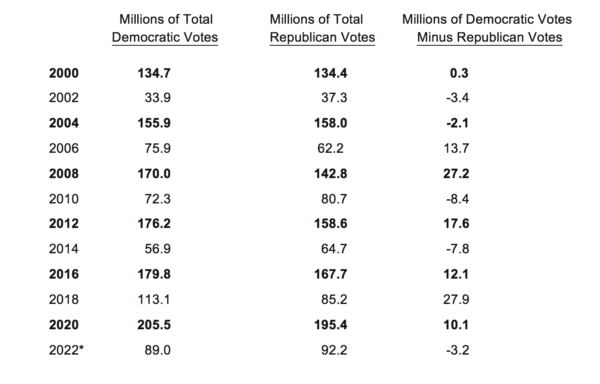News Analysis
The 2022 midterm elections show U.S. voters are more sharply divided than at any time since the 2000 election. Not only did voters split control over Congress, but the large number of razor-thin margins of victory point to a potential windfall of victories for the party that captures swing voters in 2024.
The economy and the unique characteristics of the candidates will certainly play an important role in the next election. In addition, voting patterns from past elections can yield interesting insights into what to expect in the next election cycle.
The Federal Election Commission provides extensive data on votes for the House, Senate, and presidency by political party. The following table shows the total votes in millions going to Democrat candidates and Republican candidates in each national election since 2000. The table also shows the margin by which the total votes for Democrats exceeded or fell short of the total of Republican votes.
Voting Patterns in Federal Elections 2000 to 2022

The vote totals soar in presidential election years for two reasons. More people vote in presidential elections than vote in off-year elections. In addition, votes in non-presidential years include only votes for Congress while votes in presidential years add votes for president to those for Congress.
Another interesting point is how the margins of total votes tend to favor Democrats. When Democrats win, they tend to win by large margins. In contrast, Republican victories tend to come on smaller margins, or even on negative margins.
The George W. Bush victory in the 2000 election came with a national total vote margin of only 300,000 more Republican votes for all candidates. Similarly, Donald Trump’s victory in 2016 occurred despite an overall excess of 12 million more Democrat votes nationally than for Republicans in the House, Senate, and presidency. In the presidential race alone, candidate Hillary Clinton received almost three million more votes than Trump. While Trump brought out a substantial number of new voters, Republican votes were more than offset by the increase in votes for Democrats. From this perspective, the idea of a massive Trump turnout in 2016 did not happen.
In each presidential election year since 2008, Democrat votes exceeded Republican votes by more than 10 million. The smallest margin was the 10.1 million total Democrat votes in the 2020 election. This pattern in presidential election years suggests Democrats have a distinct advantage in getting voters to vote for them in the next presidential election.
Examining votes along party lines in the House and Senate elections reveals another potentially insightful pattern. In the elections of 2006, 2008, and 2018, Democrat vote margins were significant in terms of winning both the House and Senate, as well as the presidency in 2008.
In contrast, Republican victories in the off-presidential years of 2002, 2010, and 2014 were by less than 10 million votes. In other years, it was common for one party to win the Senate and lose the House or vice versa. The main exception to this was the 2018 election, which turned into a blowout with Democrats achieving a 19.5 percent margin of votes in the Senate and a 9 percent margin in the House.
These voting patterns have several implications for the 2024 election.
First, with voters sharply divided over politics, the odds seem to favor a very close election as in 2000, where the national vote split 50–50 between Democrats and Republicans.
Second, swing voters are more inclined to go from one party to another depending on the unique characteristics of the candidates. These voters came out modestly for Bush in 2004, and switched heavily to Obama in 2008 and 2012. Swing voters provided little support for Trump in 2016, then shifted heavily to Democrats in 2018. In 2020, swing voters provided support for Biden with a margin of 4.7 percent over Trump and a margin of 3.1 percent in the House. In the Senate, the vote margin favored Republicans by 1.8 percent.
In the 2022 election, swing voters shifted slightly toward Republicans. The Cook Political Report National House Vote Tracker shows Republicans achieved a 1.7 percent margin of votes in the House elections. In the Senate, the vote split evenly, with 38 million voting for Republicans and 38 million voting for Democrats.
Each party has its core voters whose votes are normally driven primarily by their party’s ideology. Swing voters are crucial to winning elections, particularly closely fought elections. Voting patterns in recent elections appear to show swing voters less driven by ideology and more concerned with candidates’ qualities and characteristics. If this is the case, the successful party in the 2024 election will be the one whose candidates are best at appealing to swing voters.
In addition to choosing the right candidates, Republicans have an additional handicap going into the 2024 elections. Robert Epstein, senior research psychologist at the American Institute for Behavioral Research and Technology, tracks the bias in tech companies’ information and how it impacts voters. His analysis shows tech company information bias switched at least 6 million votes in the 2020 elections to Democrats.
In his recent opinion article for The Epoch Times “How Google Stopped the Red Wave,” Epstein explains how the tech companies’ information bias shifted millions of votes to Democrats in the 2022 midterm election. This shift explains how Democrats were able to hold off what Epstein claims would have been a red wave for Republicans.
Regardless of who Republicans choose to run in 2024, if tech companies retain the ability to shift tens of millions of votes to Democrats, Republicans will face a substantial obstacle to regaining control over Congress and the presidency.









